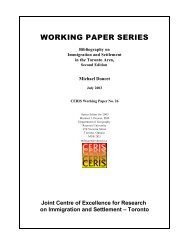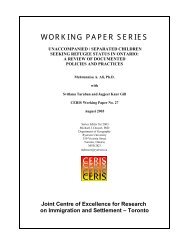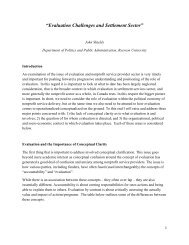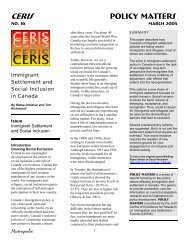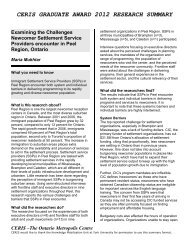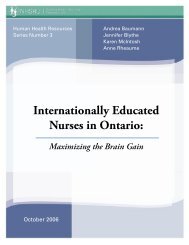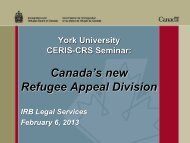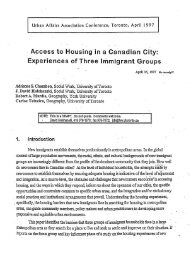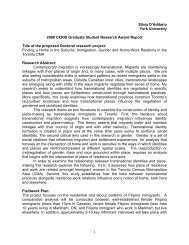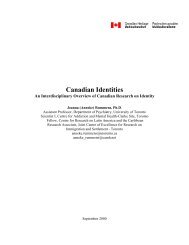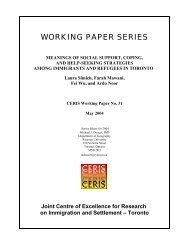Ethno-Racial Inequality in the City of Toronto: An Analysis of the ...
Ethno-Racial Inequality in the City of Toronto: An Analysis of the ...
Ethno-Racial Inequality in the City of Toronto: An Analysis of the ...
You also want an ePaper? Increase the reach of your titles
YUMPU automatically turns print PDFs into web optimized ePapers that Google loves.
Educational Atta<strong>in</strong>ment <strong>of</strong> AdultsAbout 30 percent <strong>of</strong> <strong>Toronto</strong>nians between 25 and 64 have not completed high school, and about 15percent have only primary school education. Almost one-quarter <strong>of</strong> <strong>the</strong> population, 22.7 percent, areuniversity graduates, and 5.5 percent have a Master’s or higher degree. In addition 7.9 percent are tradeschool graduates and 14.0 percent are college graduates. <strong>Ethno</strong>-racial groups cannot only becharacterized <strong>in</strong> terms <strong>of</strong> “more”or “less” education. A group may have a high level <strong>of</strong> basic literacy,measured by <strong>the</strong> proportion <strong>of</strong> high school graduates, but relatively few university graduates, restrict<strong>in</strong>gaccess to jobs requir<strong>in</strong>g high qualifications and <strong>of</strong>fer<strong>in</strong>g high pay. Interest<strong>in</strong>gly, <strong>the</strong>re is relatively littlevariation <strong>in</strong> <strong>the</strong> educational atta<strong>in</strong>ment <strong>of</strong> <strong>the</strong> broad global regions <strong>in</strong>to which group <strong>the</strong> <strong>in</strong>dividual ethnoracialgroups, but considerable variation between groups with<strong>in</strong> <strong>the</strong> regions.ABORIGINAL ORIGINAmong Aborig<strong>in</strong>als, <strong>the</strong>re are slightly fewer non-high school graduates than <strong>in</strong> <strong>the</strong> total population andnearly as many university graduates, <strong>the</strong> figures are 27.6 versus 30.5 percent, respectively. Threecomponents <strong>of</strong> this category, however, are strik<strong>in</strong>gly different: 42.6 percent <strong>of</strong> <strong>Toronto</strong>nians who are onlyAborig<strong>in</strong>al have not graduated from high school and just 6.0 percent are university graduates; whilepeople with Aborig<strong>in</strong>al and any o<strong>the</strong>r background have considerably more education, so <strong>the</strong>ir educationalpr<strong>of</strong>ile is close to <strong>the</strong> average for <strong>Toronto</strong>.AFRICAN, BLACK AND CARIBBEAN ORIGINSimilar variation is found with<strong>in</strong> <strong>the</strong> “African, Black and Caribbean” category. In total, 26.7 percenthave not completed high school and 10.7 percent are university graduates, compared to 30.5 percent nonhighschool graduates and 22.7 percent university graduates <strong>in</strong> <strong>the</strong> population. The lowest percentages <strong>of</strong>non-high school graduates, above 30 percent, are found among <strong>the</strong> Ghanaians, Guyanese and Jamaicans,and <strong>the</strong> “African and Black” group. Relatively few university graduates, below 9 percent, are found <strong>in</strong><strong>the</strong> Somali, <strong>the</strong> “African and Black,” Guyanese, Jamaican, and “West Indian” groups. <strong>Toronto</strong>nians withAfrican, Black or Caribbean ancestry and also European, Arabic, West Asian or East Asian backgroundhave relatively high levels <strong>of</strong> education.<strong>Ethno</strong>-<strong>Racial</strong> <strong>Inequality</strong> <strong>in</strong> <strong>Toronto</strong>: <strong>An</strong>alysis <strong>of</strong> <strong>the</strong> 1996 Census 41



